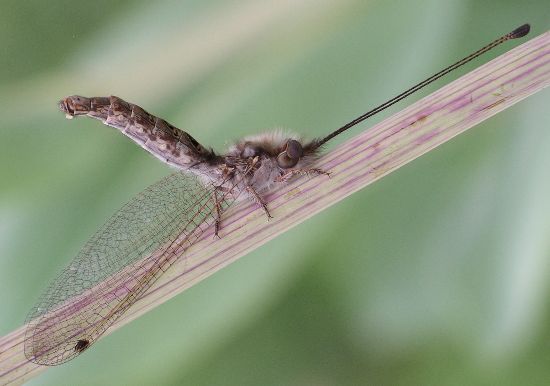by Valerie
July, 2006Owlfly This month we feature a fascinating insect called an owlfly (Ululodes hyalina). While they are not particularly rare, I might go for a year or two without seeing any and then see several in one season. This year has been a good one for sightings, and they have been very evident. Owlflies are in the order Neuroptera, along with lacewings and antlions. They are about an inch long, not including the antennae, which are about as long as the wings. When flying, these insects resemble antlions or damselflies, moving rather slowly and not staying aloft for very long. More often, owlflies can be found resting cryptically on stems or twigs. They typically hug tightly to branches, but when disturbed they raise their abdomens. It takes very little to disturb them, so it has even been suggested that this is the typical resting position. Since I've seen them rest with their abdomens down several times, I think it is more a defensive gesture. I thought they might release some chemical when they do this, but have never noticed any smell. The raised abdomen looks much like a stick from a distance, which could help with camouflage. The wings have a spot on them that looks just like the tips of the antennae, further confusing would-be predators as to which end is the head. From the top, the tip of the raised abdomen presents two white spots with small black dots in the middle of each, looking very much like a bizarre pair of eyes. The eggs of owlflies are almost as strange as the adult insects. They are laid in a pair of rows at the tip of a slender twig or spine. I've found them on the leaf tips of our yuccas and agaves, as well as on dead stems of vines. On the side of the stem that is attached, the owlfly creates a barrier of little projections. These are arrayed in a spiral that encircles the twig at least 6-7 times. The little projections are sticky, from the number of tiny flies and other insects that tend to get stuck on them. They probably serve to protect the eggs from marauding ants or other insects that might want an easy meal. One other possibility is that the sticky stuff actually attracts tiny insects, which might provide the hatchling owlflies with their first meals. Once the eggs hatch, the young, in very un-predator-like fashion, actually remain clinging in a tight group to the stem. Their jaws open over 180° and the stem appears to be fuzzy with the insects. Within a couple of days, the young drop off and begin solitary hunting. One other very odd thing about owlflies is their eyes. Besides being quite large, the eyes appear to be split, as if each one is actually two different eyes overlapping. These "double" eyes wrap around the sides of the head. When the eyes are photographed with flash, the top and bottom halves reflect differently, as if they have diverse structures. |